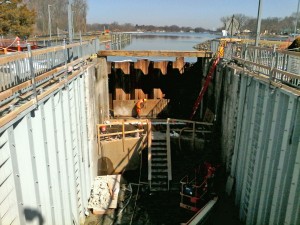McHenry’s lock and dam undergoing revitalization
Gregory Harutunian — April 12, 2015
A lone workman is seen silhouetted against the temporary lock wall, on the north end. Photo by Gregory Harutunian
It has been almost one decade in the making but improvements to the William G. Stratton Lock and Dam began in earnest Aug. 2014, the first since the 1960s, with a five-part revitalization effort aimed at upgrading the structures. The Illinois Department of Natural Resources sees the project as necessary, and able to meet future usage demands.
The lock itself is now receiving the lion’s share of attention as its navigation season, which runs from May 1 to Oct. 31, is looming. The Stratton dam, and one at Algonquin, was constructed to maintain water pools sufficient for recreation on the river and the Chain of Lakes area.
“Personally speaking, the entire project is within the arena of the general public’s safety, well-being, and leisure time spent,” said John Palmieri, the Stratton Dam’s lockmaster and site manager. “Construction is on time with the schedule presented to the state of Illinois.”
The Nov. 1, 2016 completion date encompasses the replacement of sluice gates for the dam with torque tube gates designed to manage the water flow during normal levels. There is inadequate storage for water, during flood events, and the gates are then used to minimize the water damage throughout the region.

Stratton Lockmaster John Palmieri, and IDNR’s site manager Chris Hoffman, survey the work from a temporary bridge looking at the extended lock construction. Photo by Gregory Harutunian
“The lock allows boats to traverse from the lower water level downstream of the dam to the higher water level above the dam and vice versa, and the lock is not used to control water levels,” said Rick Pohlman, IDNR’s project implementation.section “Both dams were constructed to maintain pools sufficient for recreation on the Fox River and Chain of Lakes.
In June 2005, the Chicago-based firm of HTNB Corp. completed an engineering study with the recommendations that the sluice gates be replaced and the lock extended. ”We had three other firms review the findings for accuracy, and cost-effectiveness involving taxpayer funds,” said Ted Montrey, IDNR’s chief of design in water resources.
By Sept. 2011, engineering plans were on the table and eventually entailed a five-part program: a 60-foot downstream lock extension with a new intake pipe, lockhouse renovations, north berm entry improvements, new gate structure (to be constructed upstream of existing gate structure) with three 28-foot wide torque tube gates, and demolition of the existing gate structure.
The last part included Algonquin Dam Control remote monitoring and operation, as part of a downriver portion that will also share information with Srpingfield’s IDNR office for closures and “no-wake” edicts.
The apportioned cost of $16,679,000 stipulated that the Schaumburg-based general contractor Keiwit Infrastructure Inc. would employ sub-contractors to complete the project. Additionally, this project has a Disadvantaged Business Enterprise (DBE) participation goal of 8 per cent, with an earmark totaling approximately $1.3 million.
Further studies indicated that boat traffic in 2013 amounted to 6,693 Lockages and 10,088 Boats, while in 2014, there was an increase in usage with 7,264 lockages and 11,268 boats. Factors influencing the number of boats include the economy, gas prices and weather.
“Overall, the new locks will equate to more vessels being able to pass through,” said Chris Hoffman, IDNR’s site supervisor. “The idea of the extension of the locks is to decrease waiting time, and negate traffic back-ups.”
One important development was the northern entry point of the lock, and a new berm being installed. “The northern berm is being refurbished to keep the river within its banks,” said Palmieri. “There were serious erosional concerns over the years that the state needed to reinforce it.
“I’ve been here 9 years as lockmaster, and this is a great project, with the improvements eying future use and capabilities.”







